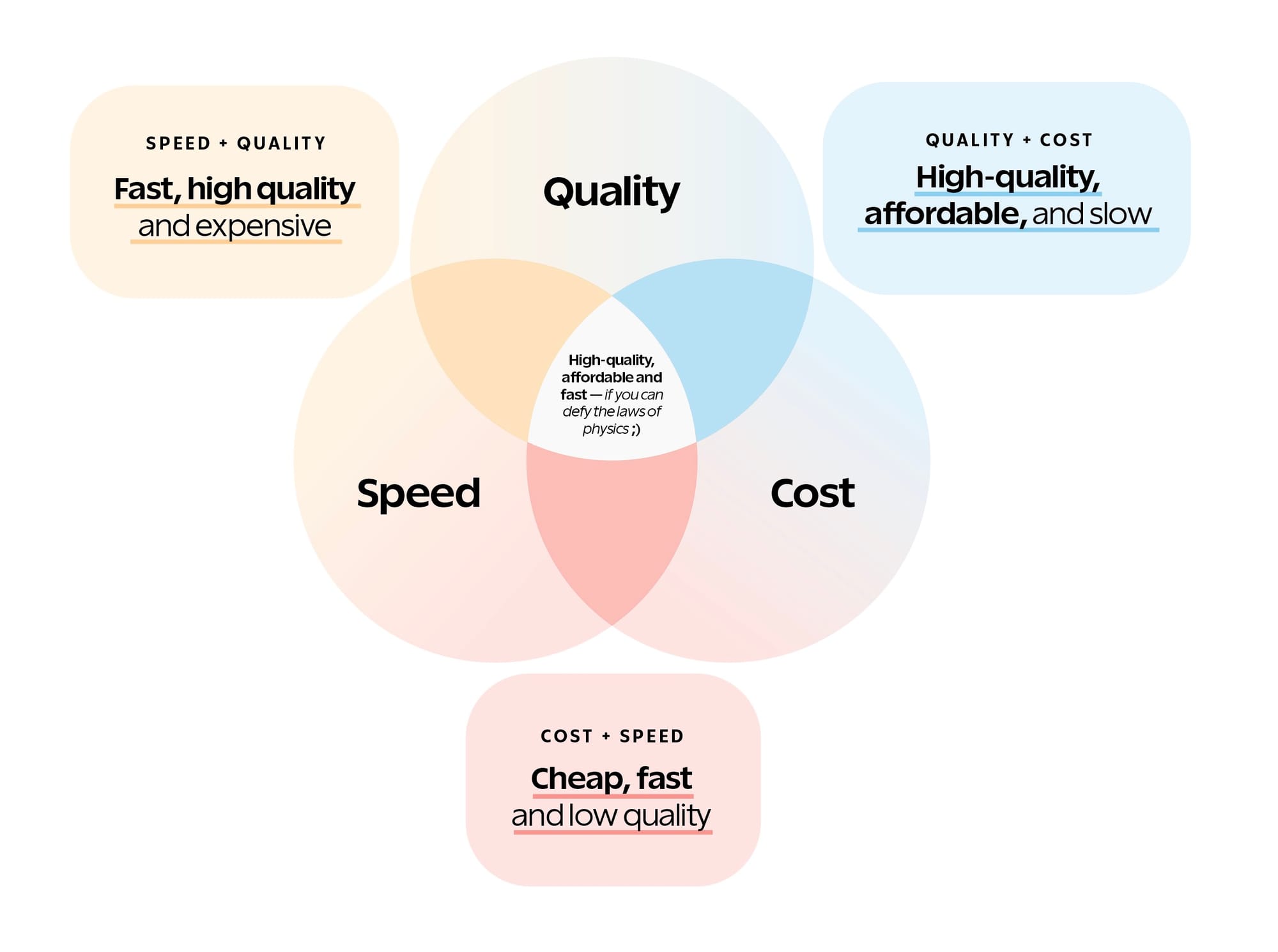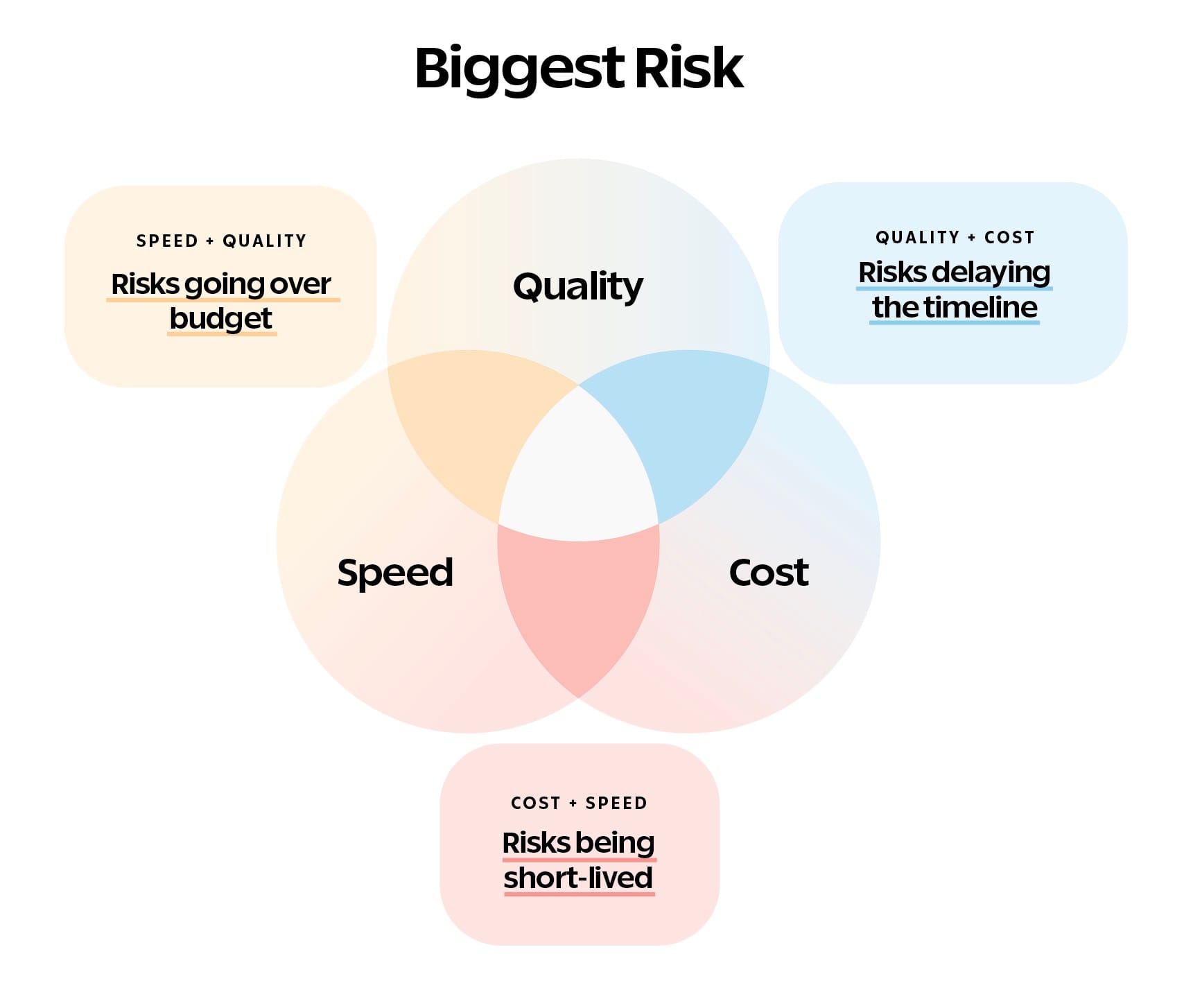The Tradeoff Triad
You will make thousands of decisions throughout your homebuilding journey. Each of those decisions will have three core aspects: Speed, Quality and Cost. Understanding how those aspects affect your timeline, scope and budget are crucial to making the right decisions at the right time.

Decisions, decisions, decisions
Across the life of your project, you will make thousands of decisions. Each of those decisions will have three core aspects:
- Speed: How fast the item can be produced, fabricated and/or installed
- Quality: How elegant, long-lasting and custom the item is
- Cost: How much the item costs to obtain, fabricate and/or install
Each of these core elements is intertwined with a core element of your project:
- Speed affects Timeline — How long it takes to complete the project
- Quality affects Scope — How well the finished product meets your vision
- Cost affects Budget — How much the project costs to execute
Best two out of three
If it was possible to optimize for speed, quality and cost on every aspect of your project, this post wouldn’t need to exist. But in homebuilding, as in life, there are tradeoffs. At best, you will most often succeed in optimizing for two of the aspects at the expense of the third:
This creates three typical scenarios:

- Optimize for Speed and Quality, not Cost: These items will be fast and high quality, but will carry a higher cost. Examples include:
- A beautiful natural stone slab for your countertop that is readily available
- Expensive tile that’s in stock and has all of the trim pieces you need
- Custom cabinetry from a local cabinet shop that can turn it around in eight weeks or less
- Optimize for Quality and Cost, not Speed: These items will be high quality and affordable, but will potentially cause a delay in your project timeline. Examples in this category are rare, but some include:
- Hardwood flooring at a good value that won’t be back in stock for three months
- Semi-custom cabinetry from Europe that takes five months to arrive
- A seasonal deal on appliances that have a 12-month lead time
- Optimize for Cost and Speed, not Quality: These items will be affordable and fast, but significantly lower in quality than other available options. Examples in this category are sadly abundant. These are just a few:
- A cheap pre-fabricated bathroom vanity from a local box store
- Flooring material that is inexpensive but won’t hold up to regular use
- The work of any builder or tradesperson whose price seems too good to be true
Risk factors
The two areas you’ve optimized for cast a shadow on the third — and that shadow represents the potential risk associated with making that aspect last priority:

The fallout from these risks should not be underestimated:
- Optimize for Speed and Quality, not Cost: While you’ll benefit from getting a great product on a great timeline, be prepared to go over budget — sometimes significantly — in order to reap those benefits.
- Optimize for Quality and Cost, not Speed: Depending on the item and how much space there is in your timeline, the wait may justify the quality or affordability you may get in exchange for a slower turnaround.
- Optimize for Cost and Speed, not Quality: This is the most tempting category. It’s easy to write off the lower quality of an item if it seems like a great deal and is readily available. The real hidden risk here, though, isn’t actually Quality — it’s Cost: When a affordable, fast item fails, it may not only be expensive to replace but it can also (in the case of a poor plumbing fixture, for example) cause damage that is orders of magnitude more than you initially paid — and also more than it would have cost to go with the quality option the first time. Tread carefully when making a decision in this category.
At the heart of each of these decisions is the priorities you set in pursuit of your vision (see Why We Build). The act of making those decisions, however, carry an impact upon the timeline, scope and budget. Knowing how to balance your priorities with their impact will you make you a more effective decision maker throughout the project — and help you feel more confident about your decisions in the long run.